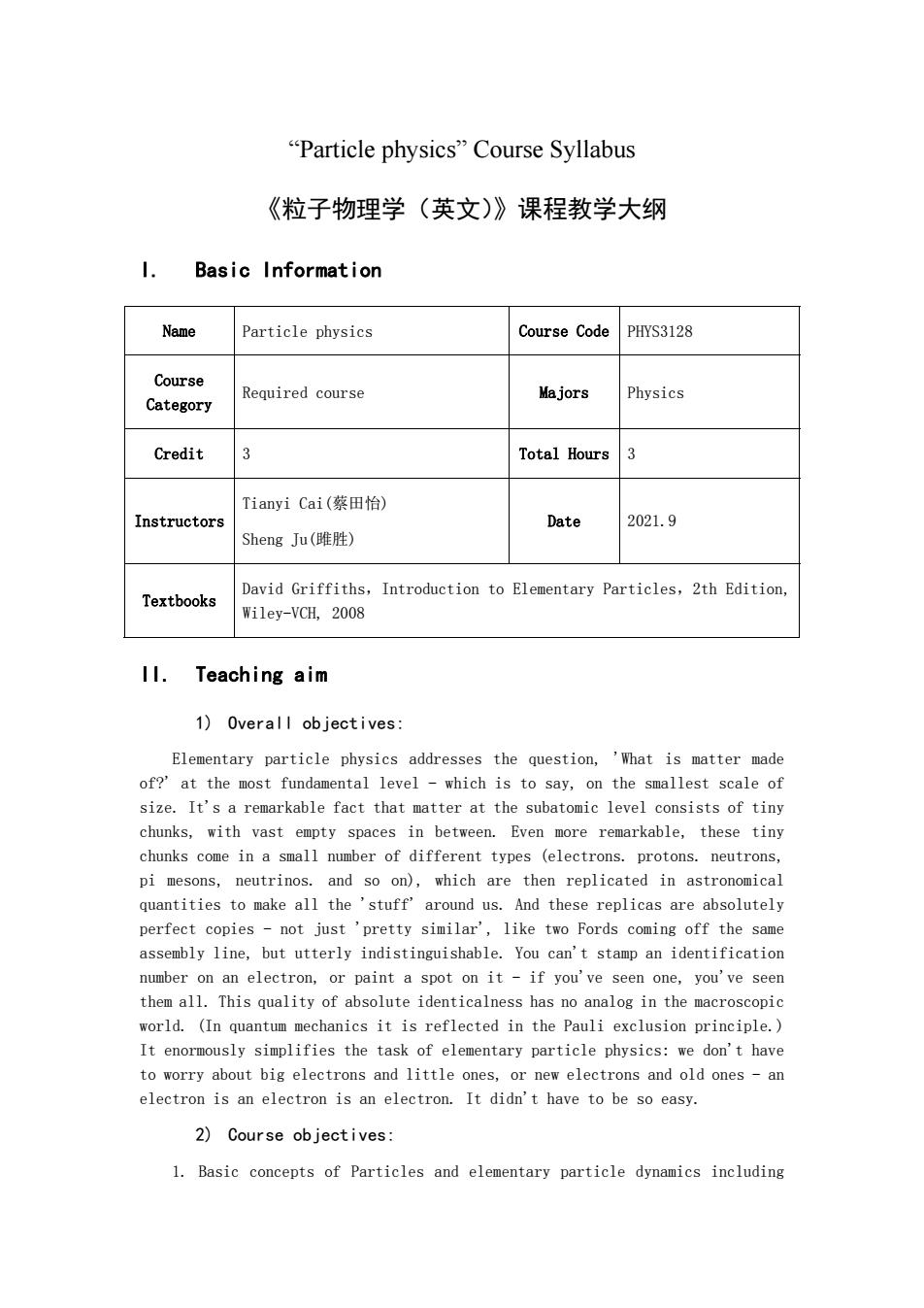正在加载图片...

"Particle physics"Course Syllabus 《粒子物理学(英文)》课程教学大纲 1. Basic Information Name Particle physics Course CodePHYS3128 Course Category Required course Majors Physics Credit Total Hours3 Tianyi Cai(蔡田怡) Instructors Date 2021.9 Sheng Ju(睢胜) Textbooks David Griffiths,Introduction to Elementary Particles,2th Edition, Wiley-VCH.2008 1I.Teaching aim 1)Overall objectives: Elementary particle physics addresses the question,'What is matter made of?at the most funda ental level-which is to say, on the smallest scale of size.It's a remarkable fact that matter at the subatomic level consists of tiny chunks,with vast empty spaces in between.Even more remarkable,these tiny chunks come in a small number of different types (electrons.protons.neutrons, pi mesons.neutrinos.and so on).which are then replicated in astronomical quantities to make all the'stuff'around us.And thes replicas are absolutely perfect copies-not just'pretty similar like two Fords coming off the same assembly line,but utterly indistinguishable.You can't stamp an identification number on an electron,or paint a spot on it-if you've seen one,you've seen them all.This quality of absolute identicalness has no analog in the macroscopic world.(In quantum mechanics it is reflected in the Pauli exclusion principle.) It enormously simplifies the task of elementary particle physics:e don't have to worry about big electrons and little ones,or new electrons and old ones-an electron is an electron is an electron.It didn't have to be so easy. 2)Course objectives: 1.Basic concepts of Particles and elementary particle dynamics including “Particle physics” Course Syllabus 《粒子物理学(英文)》课程教学大纲 I. Basic Information Name Particle physics Course Code PHYS3128 Course Category Required course Majors Physics Credit 3 Total Hours 3 Instructors Tianyi Cai(蔡田怡) Sheng Ju(雎胜) Date 2021.9 Textbooks David Griffiths,Introduction to Elementary Particles,2th Edition, Wiley-VCH, 2008 II. Teaching aim 1) Overall objectives: Elementary particle physics addresses the question, 'What is matter made of?' at the most fundamental level - which is to say, on the smallest scale of size. It's a remarkable fact that matter at the subatomic level consists of tiny chunks, with vast empty spaces in between. Even more remarkable, these tiny chunks come in a small number of different types (electrons. protons. neutrons, pi mesons, neutrinos. and so on), which are then replicated in astronomical quantities to make all the 'stuff' around us. And these replicas are absolutely perfect copies - not just 'pretty similar', like two Fords coming off the same assembly line, but utterly indistinguishable. You can't stamp an identification number on an electron, or paint a spot on it - if you've seen one, you've seen them all. This quality of absolute identicalness has no analog in the macroscopic world. (In quantum mechanics it is reflected in the Pauli exclusion principle.) It enormously simplifies the task of elementary particle physics: we don't have to worry about big electrons and little ones, or new electrons and old ones - an electron is an electron is an electron. It didn't have to be so easy. 2) Course objectives: 1. Basic concepts of Particles and elementary particle dynamics including